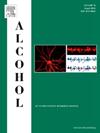Alcohol use disorder-associated pain: clinical and preclinical evidence
IF 2.9
4区 医学
Q3 PHARMACOLOGY & PHARMACY
引用次数: 0
Abstract
Alcohol Use Disorder (AUD) affects millions of people globally and is characterized by cycles of intoxication, withdrawal, and relapse. Convergent clinical and preclinical evidence strongly support the conclusion that AUD precipitates chronic pain marked by mechanical and thermal hypersensitivity, yet currently available FDA-approved therapeutics do not effectively manage AUD-associated pain. This review synthesizes clinical and preclinical evidence on AUD-associated pain, highlighting known phenomena of allodynia and hyperalgesia as well as small and/or large fiber neuropathy in patient subpopulations along with preclinical acute and chronic alcohol exposure paradigm-specific nociceptive phenotypes in rodents. Herein, we provide detailed descriptions and interpretations of outcome measures for different sensory modalities typically utilized in clinical and/or preclinical studies of nociception. We examine how these endpoints vary in rodent models according to the type of alcohol exposure paradigm with regard to route of administration, chronicity, and contingency (forced, voluntary, or combined). Finally, we summarize the prominent molecular mechanisms that have been proposed to mediate alcohol withdrawal-induced pain-like behaviors. While major advances have been made in treatment of AUD, critical gaps in understanding of human pain phenotypes due to lack of quantitative endpoints in clinical trials impede further advancement in refining preclinical models to recapitulate these features. Patient phenotype-driven preclinical models will increase cross-species translational potential for interrogating mechanistic underpinnings and thereby inform future drug discovery campaigns for treatment of AUD-associated pain.
酒精使用障碍相关疼痛:临床和临床前证据
酒精使用障碍(AUD)影响着全球数百万人,其特点是中毒、戒断和复发的循环。越来越多的临床和临床前证据强烈支持AUD沉淀慢性疼痛的结论,其特征是机械和热超敏反应,但目前fda批准的治疗方法并不能有效地控制AUD相关的疼痛。本综述综合了aud相关疼痛的临床和临床前证据,强调了患者亚群中已知的异位性疼痛和痛觉过敏现象,以及小纤维和/或大纤维神经病变,以及啮齿动物临床前急性和慢性酒精暴露范式特异性伤害感受表型。在此,我们提供了对临床和/或临床前研究中通常使用的不同感觉模式的结果测量的详细描述和解释。我们研究了这些终点在啮齿动物模型中如何根据酒精暴露范式的类型与给药途径、慢性性和偶然性(强制、自愿或联合)有关。最后,我们总结了已经提出的介导酒精戒断诱导的疼痛样行为的主要分子机制。虽然在治疗AUD方面取得了重大进展,但由于缺乏临床试验的定量终点,对人类疼痛表型的理解存在重大差距,这阻碍了进一步完善临床前模型以概括这些特征。患者表型驱动的临床前模型将增加询问机制基础的跨物种转化潜力,从而为未来治疗aud相关疼痛的药物发现活动提供信息。
本文章由计算机程序翻译,如有差异,请以英文原文为准。
求助全文
约1分钟内获得全文
求助全文
来源期刊

Alcohol
医学-毒理学
CiteScore
4.60
自引率
4.30%
发文量
74
审稿时长
15.6 weeks
期刊介绍:
Alcohol is an international, peer-reviewed journal that is devoted to publishing multi-disciplinary biomedical research on all aspects of the actions or effects of alcohol on the nervous system or on other organ systems. Emphasis is given to studies into the causes and consequences of alcohol abuse and alcoholism, and biomedical aspects of diagnosis, etiology, treatment or prevention of alcohol-related health effects.
Intended for both research scientists and practicing clinicians, the journal publishes original research on the neurobiological, neurobehavioral, and pathophysiological processes associated with alcohol drinking, alcohol abuse, alcohol-seeking behavior, tolerance, dependence, withdrawal, protracted abstinence, and relapse. In addition, the journal reports studies on the effects alcohol on brain mechanisms of neuroplasticity over the life span, biological factors associated with adolescent alcohol abuse, pharmacotherapeutic strategies in the treatment of alcoholism, biological and biochemical markers of alcohol abuse and alcoholism, pathological effects of uncontrolled drinking, biomedical and molecular factors in the effects on liver, immune system, and other organ systems, and biomedical aspects of fetal alcohol spectrum disorder including mechanisms of damage, diagnosis and early detection, treatment, and prevention. Articles are published from all levels of biomedical inquiry, including the following: molecular and cellular studies of alcohol''s actions in vitro and in vivo; animal model studies of genetic, pharmacological, behavioral, developmental or pathophysiological aspects of alcohol; human studies of genetic, behavioral, cognitive, neuroimaging, or pathological aspects of alcohol drinking; clinical studies of diagnosis (including dual diagnosis), treatment, prevention, and epidemiology. The journal will publish 9 issues per year; the accepted abbreviation for Alcohol for bibliographic citation is Alcohol.
 求助内容:
求助内容: 应助结果提醒方式:
应助结果提醒方式:


